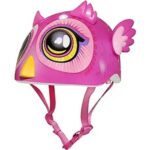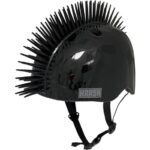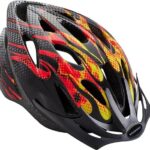As we pedal through the landscape of helmet safety, the unveiling of the new CPSC standard for bicycle helmets beckons our attention. Understanding the intricate details of this standard is like navigating a complex maze with hidden treasures awaiting discovery.
Join us as we unravel the layers of this critical development, shedding light on what cyclists need to know to enhance their safety on the road.
Key Takeaways
- Stronger chin straps mandated for secure helmet attachment.
- Children up to age five require helmets covering more of the head.
- CPSC label ensures compliance with new mandatory safety standards.
- Changes aim to enhance overall helmet safety and reduce head injuries.
Overview of CPSC Bicycle Helmet Standard
In our examination of the CPSC Bicycle Helmet Standard, we find a crucial focus on enhancing head protection in bicycle incidents. Bicycle helmets provide a vital safety measure, especially considering that over 900 individuals, 200 of whom are children, lose their lives yearly in bike accidents, with 60% of these fatalities involving head injuries.
The CPSC standard plays a pivotal role in reducing such incidents by ensuring that all helmets made or imported for sale in the U.S. meet specific safety criteria. Studies show that helmets can decrease the risk of head injuries by up to 85%, underscoring the importance of complying with these standards.
Notably, the new CPSC standard mandates that helmets for children up to age five cover more of the head to offer enhanced protection. This aligns with the overarching goal of safeguarding individuals while they enjoy the freedom of cycling, making adherence to CPSC bicycle helmet standards imperative for all.
Key Changes in CPSC Helmet Requirements

With the implementation of the new CPSC standard for bicycle helmets, significant changes have been introduced to enhance head protection and overall safety measures.
One key change is the mandate for stronger chin straps on helmets to prevent them from coming off during falls, ensuring a more secure fit.
Additionally, helmets designed for children up to age five are now required to cover more of the head to provide enhanced protection for this vulnerable age group.
The new standard sets rigorous safety standards that all bike helmets made or imported for sale in the U.S. must meet, replacing previous voluntary standards with mandatory regulations.
Helmets meeting the new CPSC standard will feature a certification sticker for easy identification by consumers, indicating that they've undergone rigorous impact tests to ensure they meet the enhanced safety requirements.
These changes aim to improve overall helmet safety and reduce the risk of head injuries while cycling.
Impact on Helmet Safety and Design

Enhancing helmet safety and design, the new CPSC standard introduces crucial measures to reduce head injuries in bicycle incidents. To ensure helmets provide adequate head protection, they must meet the CPSC standard if made or imported for sale in the U.S.
The inclusion of strong chin straps is now mandatory to prevent helmets from coming off during falls, thereby enhancing overall safety. Additionally, children up to age five are required to wear helmets that cover more of the head, increasing protection in case of accidents.
The CPSC label on helmets signifies compliance with the new mandatory standard, replacing previous voluntary standards for improved safety. These changes signify a significant step forward in enhancing helmet safety and design, ultimately aiming to reduce the number of head injuries in bicycle incidents.
Compliance and Enforcement of CPSC Standard

Implementing the CPSC standard ensures that all bicycle helmets made or imported for sale in the U.S. must meet rigorous safety requirements to reduce the risk of head injuries. Manufacturers are obligated to ensure their helmets comply with the CPSC standard to enhance overall safety and effectiveness.
Helmets meeting the CPSC standard must feature strong chin straps to prevent them from detaching during falls, providing added protection to users. Enforcement of the CPSC standard is crucial in upholding the safety of helmets available in the market, safeguarding users from potential head injuries.
The CPSC standard sets stringent guidelines that manufacturers must adhere to, specifically designed to protect users, especially young children, by establishing a high level of safety and performance in bicycle helmets. By enforcing compliance with the CPSC standard, authorities aim to create a safer environment for cyclists and reduce the incidence of head injuries resulting from bicycle accidents.
Resources for Understanding CPSC Helmet Standard

Our guide provides comprehensive information on understanding the CPSC helmet standard, ensuring clarity and knowledge for consumers and manufacturers alike. Here are four essential resources to help you grasp the CPSC standards for bicycle helmets:
- Consumer Product Safety Commission (CPSC) Website: The CPSC website offers detailed information on the new standard, including FAQs, guides, and updates on helmet safety to keep you informed.
- Helmet Safety Videos: Various online platforms provide videos demonstrating proper helmet fitting and usage according to CPSC guidelines, ensuring you and your loved ones stay safe while cycling.
- Local Bike Shops: Visit your nearest bike shop for hands-on assistance in selecting a CPSC-certified helmet that fits correctly and meets safety standards to protect against head injuries.
- CPSC Label Guide: Learn how to identify the CPSC label on helmets, indicating compliance with the mandatory standard, to make informed purchasing decisions and prioritize safety.
Frequently Asked Questions
What Are the Safety Standards for Bicycle Helmets?
We understand safety concerns regarding bicycle helmets. Various standards like CPSC, EN-1078, ASTM F1952, and SNELL B-95 exist. These certifications set impact standards and test methods ensuring helmets meet safety requirements. It's essential to wear a properly certified helmet for protection.
What Is the CPSC Standard for Helmet Testing?
We ensure helmets meet CPSC standards by evaluating peripheral vision, retention strength, stability, and impact protection. Compliance is key for head safety. Projections that break away on impact and provide clear 105° vision are required.
Are All Bike Helmets CPSC Approved?
Yes, not all bike helmets are CPSC approved. It's crucial to look for the CPSC label when purchasing a helmet. Safety first! Make sure your helmet meets the standard for protection on your rides.
What Is the EN 1078 Safety Standard for Bicycle Helmets?
The EN 1078 safety standard for bicycle helmets focuses on cycling, skateboarding, and roller skating. It allows for lighter helmets by testing at lower heights. To meet EN 1078, helmets must transmit less than 250 Gs to the headform, potentially requiring more coverage.
Conclusion
In conclusion, the new CPSC standard for bicycle helmets is a game-changer in promoting safety for cyclists. By ensuring helmets meet stringent requirements and have strong chin straps, this standard is a vital step towards reducing head injuries.
Remember, when it comes to protecting your noggin on the road, it's better to be safe than sorry!
















